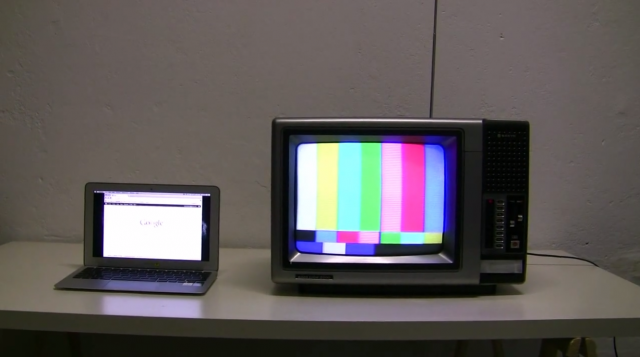RobbGodshaw-LookingOutwards-1
Föhnseher — Julian Oliver
In Föhnseher, Artist by Julian Oliver integrates a salvaged television with a Linux computer that is constantly sniffing an open WiFi network for transmitted images. It displays these images on the screen over a video test pattern background. Those nearby who are connected to the network have their thought to be private traffic prominently displayed in the gallery.
I find the execution to be clean and responsive. I appreciate that all of the technology that does not resemble the old television is hidden from view. Perhaps inside the TV chassis itself. The idea that we are sometimes broadcasting our activity to black hats and artists is likely disturbing for the viewer. The TV is as strong a symbol of publicity as our personal devices are of privacy and security.
An interesting albeit illegal method of scaling this project might include a mobile device that provides open and fast WiFi. In the same manner, images are sniffed and reproduced and converted to video signal. The signal might then be fed into an illegal television transmitter set to an unused channel. In this way, WiFi stealing neighbors would have all of their browsing habits broadcasted to the whole neighborhood on a mysterious and ephemeral channel.

Föhnseher (Seer of Warm Winds) from Julian Oliver on Vimeo.
source
DVD Dead Drop — Aram Bartholl
In this gallery installation, a unlabeled slot is cut into a blank white wall. Patrons insert their own blank dvd into the slot and it is burned with mysterious and evolving content from various digital artists.
This piece has a weirdness about it I find intriguing. Unlike USB Dead Drop, another Bartoll initiated project where USB flash drives are permanently embedding in public space, users of this installation will have no idea what they have received until they go home. DVD dead drop is also read only– giving the artist full control over what content the viewer receives.
The content Bartholl selected to be burned to the disc is not his own, but that of fellow digital artists. In this way the artist acts as nothing more than a novel and quirky content delivery mechanism. The experience of sacrificing a pristine instance of optical media to a hole in the wall for a few minutes would feel very strange. With no feedback one would likely begin to wonder when their disk would be returned. Imaginations would run wild with possibilities of content. Some users might grow to fear obscene content or malware.

source
Paper.JS — Jürg Lehni & Jonathan Puckey
Paper.JS is a port of the popular Illustrator Plug-In Scriptographer to the browser using HTML5. The landing page is a very fun little example of its Bezier capabilities. It is lively, attractive, and editable. This reduces any barriers to engaging with the tool. Until tonight, I had never heard of it. I used Scriptographer a great deal in high school for making vector half tones of graphics for screen printing. I look forward to having enough java experience to use this tool to add some spiffy and subtle interactivity to my personal website.
